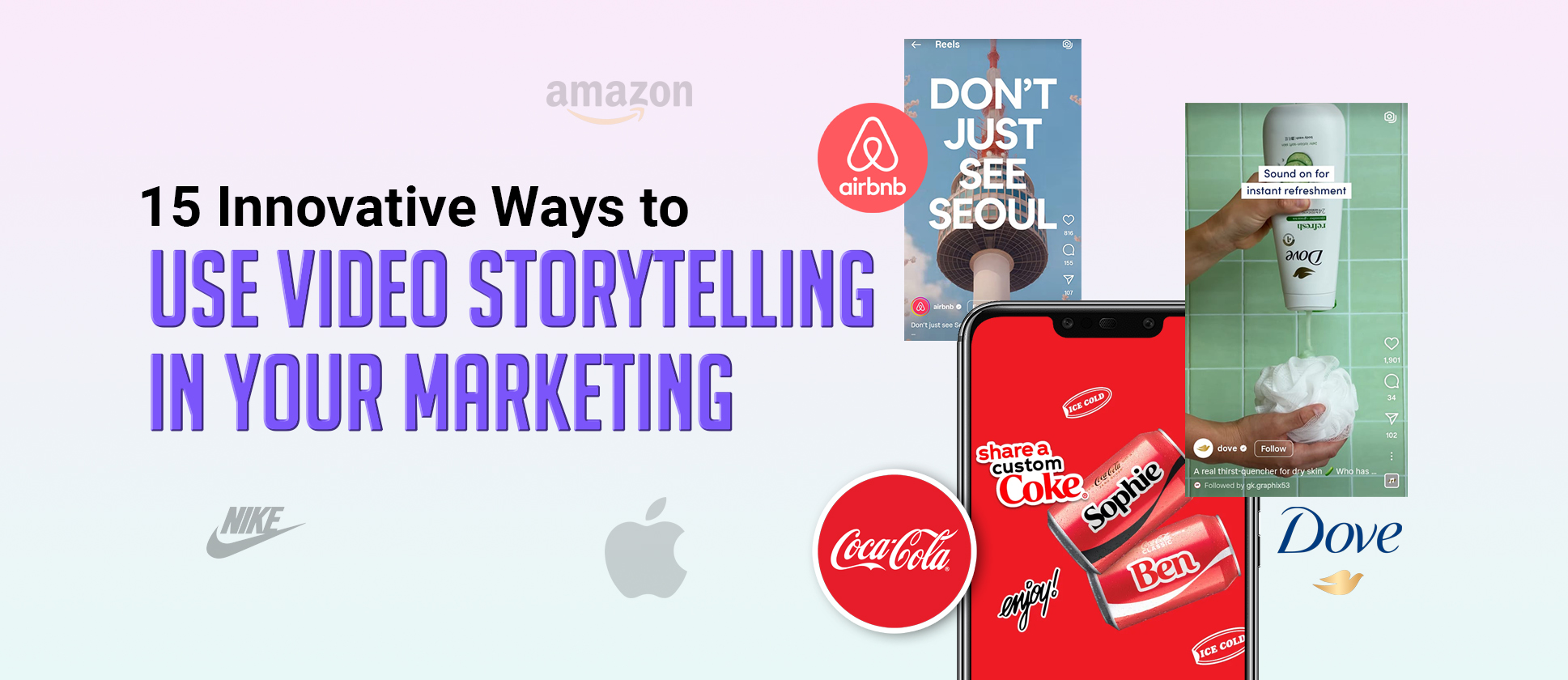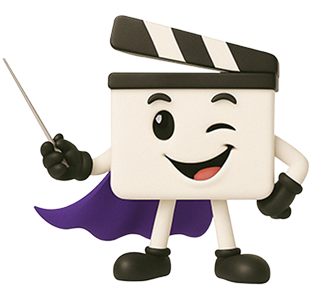From cave paintings to social media posts, stories have always been a vital part of human communication. They’re the reason we buy products, support causes, or even develop emotional connections with brands. Today, storytelling isn’t just a tradition, it’s a powerful marketing tool.
In fact, 70% of consumers say that video content is more likely to convince them to buy a product or service, and 64% of marketers report that video storytelling has helped them increase engagement with their audience. Video content allows brands to connect with their audience on a deeper, more personal level, especially in a world where attention spans are shrinking.
When you combine the art of storytelling with the impact of video, you’re not just sharing information; you’re creating experiences. In this blog, we’ll dive into how video storytelling can transform your marketing strategy, attract new customers, and build stronger relationships with your audience. Whether you’re looking to increase brand awareness or drive conversions, storytelling through video is one of the most effective ways to achieve your goals.
What is Video Storytelling?
Video storytelling is a creative way to market by combining pictures, sounds, and stories to share a brand’s message. When brands tell relatable stories in their videos, they can build a strong emotional connection with their audience. Instead of just showing products, they help viewers feel part of a bigger experience that matches their values.
The power of video stories comes from their ability to engage sight, sound, and emotion, making the message stick. Studies show that 84% of people are more likely to buy a product after watching a brand’s video.
At ShortVids, we specialize in crafting engaging video stories tailored to your brand’s unique voice and objectives. Our team is dedicated to helping you harness the power of video storytelling to connect with your audience and achieve your marketing goals.
Why Video Storytelling Matters in Marketing?
Video storytelling helps brands connect emotionally with their audience. By sharing authentic and relatable narratives, businesses can foster trust and build lasting relationships. A great example is Dove’s “Real Beauty Sketches” campaign, which resonated with many by showing the disparity between how women perceive themselves and how others see them. This led to over 163 million views and an increase in engagement for the brand.
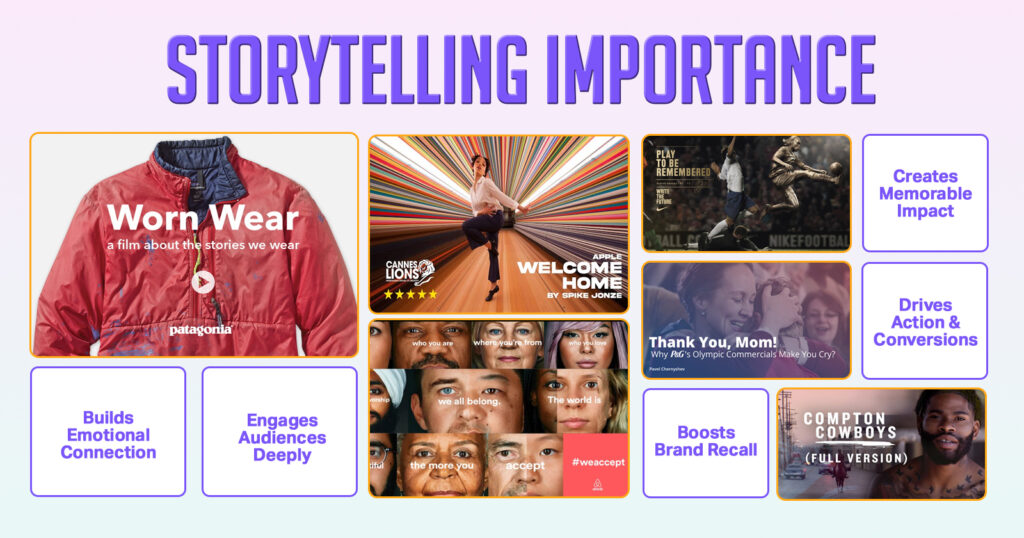
How Video Stories Enhance Brand Recognition?
Stories are more memorable than facts, making video an essential tool for brand recognition. Research shows that stories are 22 times more likely to be remembered than raw facts. Brands like Nike and Apple have effectively used storytelling to highlight their core values, leaving a lasting impact on their audience and enhancing their brand identity.
Driving Customer Action with Compelling Stories
A well-told video story doesn’t just keep the audience engaged; it also prompts action. Around 78% of consumers say watching a video has influenced their purchasing decisions. For instance, Shopify’s “First Sale Story” inspired countless entrepreneurs to start their own businesses.
At ShortVids, we specialize in creating impactful videos that not only tell your brand’s story but also convert viewers into loyal customers.
15 Creative Ways to Use Video Storytelling in Your Marketing
Video storytelling is a powerful tool for creating meaningful connections with your audience. By sharing stories that resonate emotionally, businesses can drive engagement, boost brand recognition, and encourage conversions. Here are 15 creative ways you can use video storytelling to elevate your marketing efforts.
| Number | Storytelling Type | Description |
|---|---|---|
| 1 | Personal Anecdotes | Share real-life stories to connect emotionally with your audience. |
| 2 | Case Studies | Showcase how your product or service solved a real problem. |
| 3 | Behind-the-Scenes Stories | Give a glimpse into your business processes and humanize your brand. |
| 4 | Customer Success Stories | Highlight customer journeys and how they benefited from your product. |
| 5 | Product Demos with a Narrative Twist | Combine product demos with storytelling to make them more engaging. |
| 6 | Humorous Stories | Add humor to your content to make it memorable and relatable. |
| 7 | User-Generated Content | Let your customers tell their stories, building trust and authenticity. |
| 8 | Journey Stories | Show the progression or growth of a customer or brand. |
| 9 | Fictional Scenarios | Use hypothetical situations to explain concepts or demonstrate value. |
| 10 | Day-in-the-Life Stories | Share everyday experiences of a person or brand to make the story relatable. |
| 11 | Interviews with Experts | Feature thought leaders or influencers to add authority to your content. |
| 12 | Problem-Solution Stories | Present a problem and guide the audience through the solution using your product. |
| 13 | Event Recaps | Highlight key moments from an event and tie them back to your brand message. |
| 14 | Visual Storytelling | Use images and video to tell a story more powerfully. |
| 15 | Historical Narratives | Weave in historical anecdotes or lessons to make your message stand out. |
1. Personal Anecdotes
Personal anecdotes in video storytelling are short, relatable stories that connect directly with your audience on an emotional level. By sharing a personal experience, you humanize your brand and show that you’re just like your audience. Here’s how you can use personal anecdotes in your video marketing:
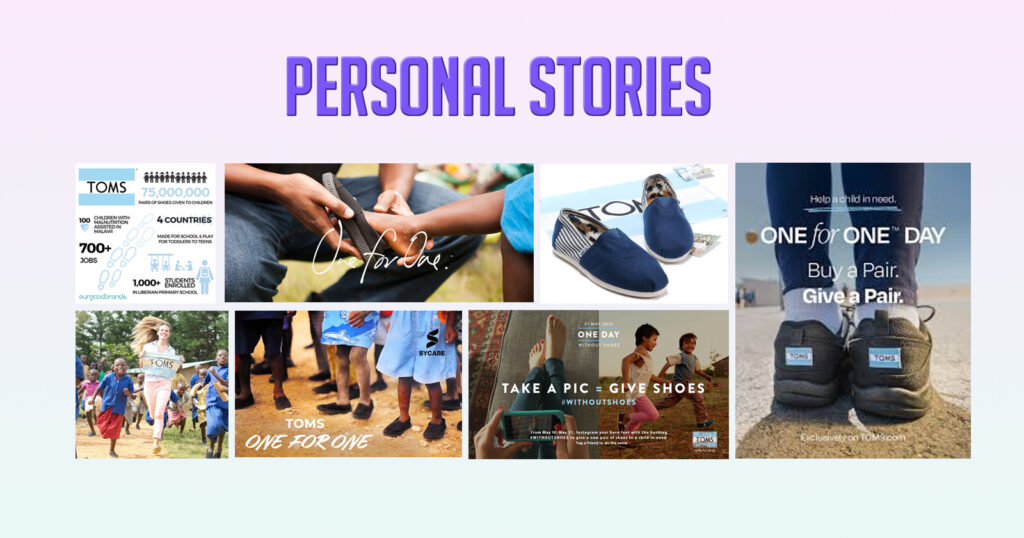
- Introduce a Story: Start with a brief personal story that relates to your product or service.
- Problem-Solution Format: Share a challenge you faced and how your product or service helped solve it.
- Authenticity is Key: Your audience wants to feel like they’re part of the journey, so be genuine and transparent
Nike often uses personal anecdotes in its ads, showcasing stories of athletes overcoming obstacles to succeed. One memorable example is their ad featuring Colin Kaepernick, where they tied his story of defiance and perseverance into their message. This resonated deeply with their audience, reinforcing Nike’s commitment to standing up for social causes.
Hamish Wilton, founder of Floss Consulting, approached ShortVids to enhance his dental practice’s online presence. We crafted a series of video testimonials featuring real patients sharing their transformative experiences. These authentic stories resonated with potential clients, leading to a significant increase in consultations and a stronger community connection.
2. Customer Success Stories
Customer success stories are compelling narratives that showcase how your product or service has positively impacted your clients. These stories not only highlight the effectiveness of your offerings but also build trust and credibility with potential customers.

Real-World Impact
For example, a small gym worked with a digital marketing company to improve its online presence. With focused social media posts and interesting content, the gym saw a 40% rise in class bookings in just three months, showing how effective smart marketing can be.
Similarly, a local bakery teamed up with a branding expert to update its logo and packaging. The new look attracted more customers and increased the number of people visiting the bakery by 25%, proving how important it is to have a strong and consistent brand.
The Power of Storytelling
These success stories work because they are easy to relate to and show real results. When businesses share stories like these, they can connect with their audience emotionally, making their products or services more attractive.
3. Behind-the-Scenes Content
Behind-the-scenes content provides a personal glimpse into how your product, team, or service is created, helping to build trust and openness with your audience. These types of stories strengthen the connection with your brand by showing the human side of what you do.
- Show the Team Behind the Work: Share videos of your team brainstorming, collaborating, or solving problems. For example, Nike shared behind-the-scenes footage of their designers working on new sneaker prototypes. This not only highlighted their craftsmanship but also built excitement for their upcoming releases.
- Product Creation Process: Take your audience through the product creation journey. For instance, Apple often shows the development stages of their products, like the iPhone, through their ads and events. This gives customers a deeper appreciation of the innovation and effort behind each device, making them more likely to trust the brand.
- Challenges and Successes: Highlight the real challenges your team faces and how you overcome them. Tesla famously shared behind-the-scenes videos of their production delays and obstacles during the creation of the Model 3. By being transparent about these hurdles, they were able to foster a stronger connection with their customers, who admired the company’s commitment to overcoming challenges.
These types of videos humanize your brand and connect with your audience on a deeper level, making them more invested in your journey.
4. Case Studies
Case studies provide compelling stories that showcase your product’s value and effectiveness through real-life examples. These stories are essential for demonstrating how your product has solved problems, achieved success, or improved a client’s situation. Below is a table of different types of case studies:
| Type of Case Study | Description |
|---|---|
| Customer Success Stories | Feature how customers have achieved their goals using your product or service. |
| Problem-Solution Case Study | Showcase a customer’s problem and how your product provided a solution. |
| Before-and-After Case Study | Highlight the changes or improvements made after implementing your product. |
| Industry-Specific Case Study | Focus on how your product performs in a particular industry, helping businesses achieve specific outcomes. |
ShortVids, with its expertise in video creation, helps companies develop effective case study videos that clearly outline the success stories of clients, making them more relatable and engaging. Our team works with you to bring the story to life with clear narratives, engaging visuals, and relatable messaging.
5. Product Demos with a Narrative Twist
Instead of just listing features, present a narrative that shows how your product solves real problems. For example, HubSpot did a great job of incorporating storytelling into their product demos by featuring real-life business challenges and how their tools provided seamless solutions.
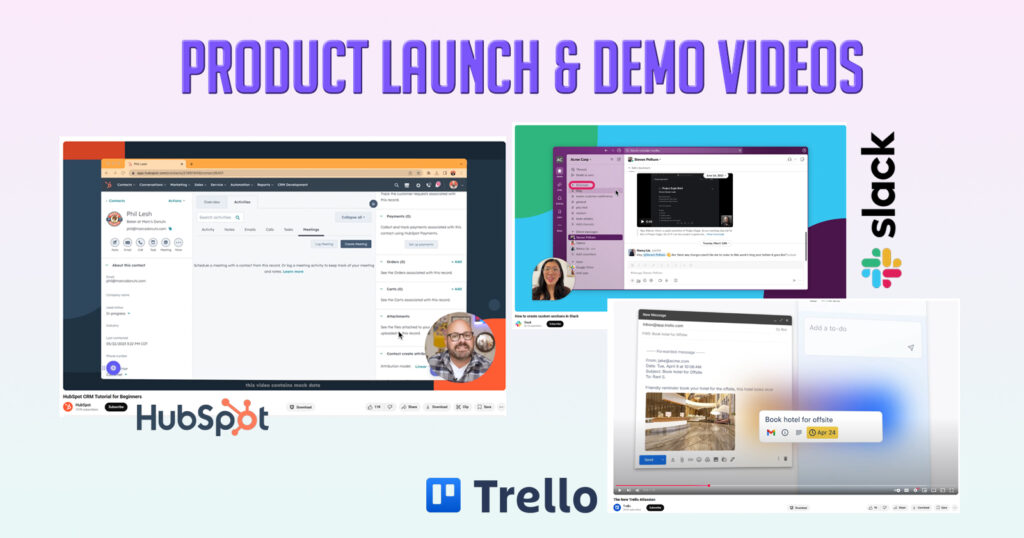
Highlighting User Experiences
A compelling product demo should not only explain how the product works but also share how it fits into a user’s daily routine. Slack did this effectively in their demo, showing how teams collaborate more efficiently using their platform, bringing out the human side of the technology.
Story-Driven Demonstrations
To make your product demos more impactful, tell a story around the product. Trello, for instance, turned their product demo into a journey of team collaboration, emphasizing how their platform simplifies teamwork. It wasn’t just about the tool; it was about making team management easier and more enjoyable.
6. Humorous Stories
Humor can be a powerful tool in storytelling, making your brand more relatable and memorable. Here are some types of humorous content you can create:
- Parody Videos: Create funny versions of popular trends or ads to engage your audience.
- Behind-the-Scenes Bloopers: Share the lighter moments from your production process.
- Character Skits: Develop recurring characters that represent your brand’s personality
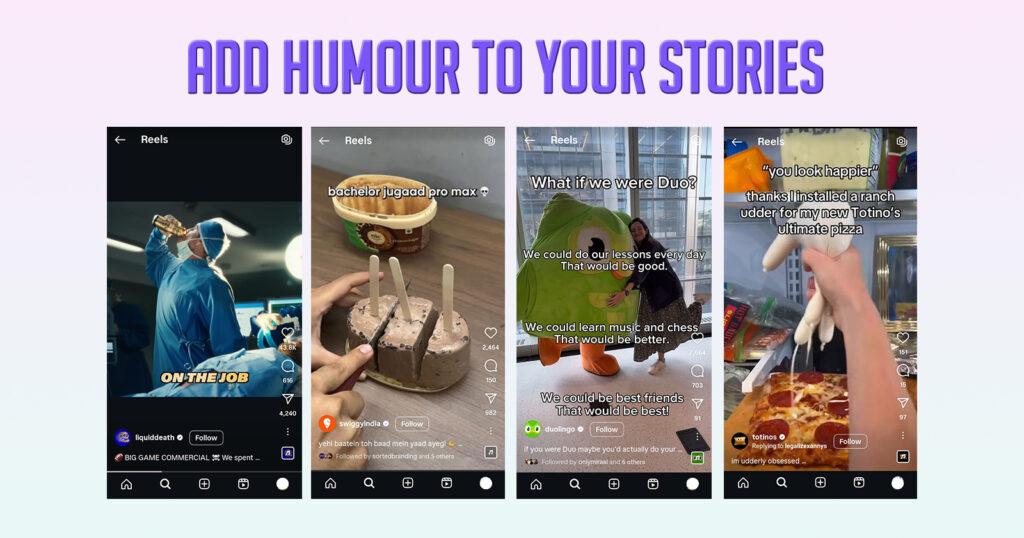
Duolingo, the language-learning app, has successfully used humor in its marketing. Their playful and sometimes mischievous owl mascot has become a recognizable figure, engaging users with witty posts and videos. This approach has helped Duolingo stand out in a competitive market.
At ShortVids, we specialize in crafting humorous video content that resonates with your audience. Our team can help you develop creative scripts, engaging visuals, and a tone that aligns with your brand’s voice, ensuring your message is both entertaining and effective.
7. User-Generated Content
User-generated content (UGC) involves leveraging content created by your customers or users, providing authenticity and building trust. Here are some types of UGC you can incorporate:
- Customer Testimonials: Showcase satisfied customers sharing their experiences.
- Product Reviews: Feature honest reviews from users highlighting the benefits of your product.
- Social Media Posts: Repost content from users who tag your brand or use your hashtag.
GoPro and Coca-Cola have both successfully harnessed the power of user-generated content to elevate their brands. GoPro encourages its customers to share their adventure videos, which the company then features on its platform, showcasing the versatility and durability of their cameras. Similarly, Coca-Cola’s “Share a Coke” campaign invited customers to find bottles with their names on them, sparking a wave of personalized content shared across social media. This strategy not only strengthened brand engagement but also created a community of brand advocates who felt personally connected to the product.
8. Journey Stories
Journey stories are powerful narratives that showcase an individual’s or brand’s transformation over time. They highlight challenges faced, lessons learned, and milestones achieved, making them relatable and inspiring for audiences. Below is a table outlining different types of journey stories:
| Type of Journey Story | Description |
|---|---|
| Personal Transformation | Chronicles an individual’s growth, overcoming personal challenges to achieve success. |
| Business Evolution | Details the progression of a business from its inception to its current state, emphasizing key turning points. |
| Customer Success | Focuses on a customer’s experience with a product or service, highlighting how it improved their situation. |
| Team Development | Shares the story of a team’s development, from initial formation to achieving collective goals. |
These stories are not just about the end result but also about the journey itself—the struggles, the perseverance, and the triumphs along the way. They resonate with audiences because they reflect real experiences and emotions.
At ShortVids, we specialize in crafting compelling journey stories that captivate audiences and drive engagement. For instance, we assisted Gene Slade, founder of Lead Ninja Inc., in transforming his sales training sessions into a lead-generating powerhouse. Through our unlimited video editing services, we repurposed his content into over 1,000 engaging videos, resulting in more than 10 million views and generating hundreds of leads daily. This approach not only amplified his reach but also solidified his authority in the sales coaching industry.
9. Fictional Scenarios
Fictional scenarios in marketing involve crafting imaginative narratives that illustrate how your product or service can solve problems or enhance experiences. These stories engage audiences by presenting relatable situations with creative twists.
Types of Fictional Scenarios
- Problem-Solution Narratives: Create a fictional character facing a challenge that your product resolves.
- Fantasy Scenarios: Imagine a world where your product exists in an exaggerated or whimsical setting.
- Alternate Realities: Present a scenario where a different choice leads to an unexpected outcome, highlighting the benefits of your offering.
Old Spice revolutionized its brand with the “The Man Your Man Could Smell Like” campaign. The ad featured a humorous and surreal narrative, showcasing the product’s benefits in an over-the-top, fictional context. This approach captured attention and significantly boosted sales.
10. Day-in-the-Life Stories
Day-in-the-life stories offer audiences a glimpse into the daily routines of individuals, showcasing how your product or service integrates into their lives. These narratives build relatability and trust by highlighting real-world applications.
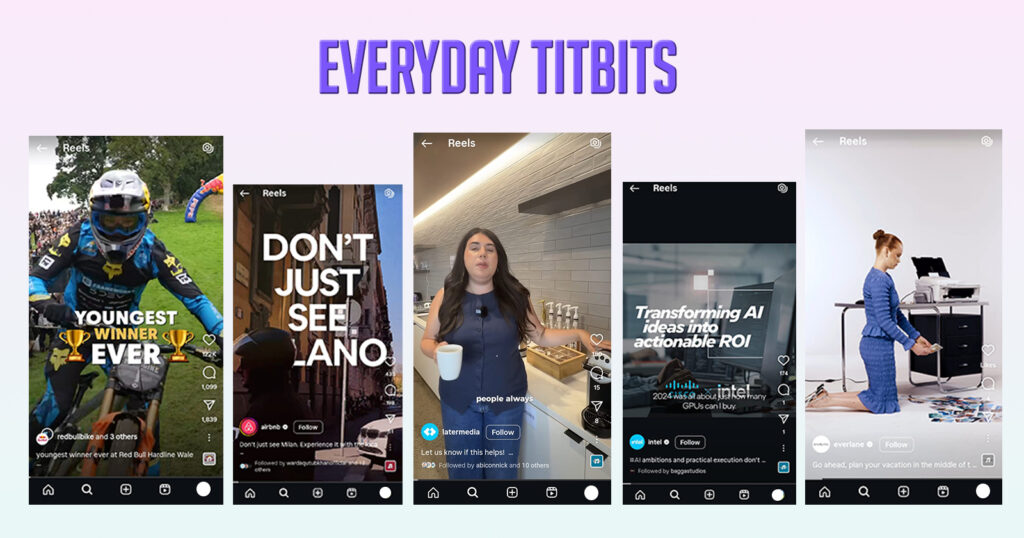
Types of Day-in-the-Life Stories
- Customer Journeys: Follow a customer through their day, emphasizing how your product solves problems or adds value.
- Employee Perspectives: Showcase a day in the life of an employee to humanize your brand and demonstrate company culture.
- Behind-the-Scenes: Provide an insider look at your operations, processes, or product creation.
Airbnb effectively used day-in-the-life storytelling in their campaign featuring a displaced family finding temporary housing through their platform. The video interwove interviews with the family and footage of their daily lives, creating an emotional narrative that resonated with viewers.
ShortVids can assist in producing authentic day-in-the-life videos that align with your brand’s voice and objectives. We work closely with you to create compelling stories that engage your audience.
11. Interviews with Experts
Interviews with experts provide authoritative insights and add credibility to your content. Featuring industry leaders or specialists discussing relevant topics can educate your audience and position your brand as a thought leader.
Types of Expert Interviews
- Industry Insights: Discuss current trends, challenges, or innovations within your industry.
- Product Expertise: Highlight the technical aspects or unique features of your product through expert commentary.
- Thought Leadership: Share visionary perspectives on the future of your industry or related fields.
Visa has embraced expert interviews as part of its marketing strategy. The company supports around 50 million creators and partners with events like the Paris Olympics to provide creators with the skills to produce content. This approach includes featuring industry experts discussing the creator economy and content creation.
Jakib Sports, covering Philadelphia’s top teams like the Eagles and 76ers, needed to enhance their content for better engagement. ShortVids helped by refining their video editing, repurposing footage, and adding captions, making their content visually appealing and accessible. We specialize in transforming raw footage into polished, engaging videos that resonate with audiences, just like Jakib Sports.
12. Problem-Solution Stories
When it comes to marketing, telling a good story can really connect with your audience. One of the best ways to do this is by using problem-solution storytelling. This is where you show the problem your customers face and then explain how your product or service is the perfect solution. It makes people feel like you understand them and that your brand can really help them out.
Here’s a simple breakdown of problem-solution storytelling:
| Problem | Solution |
|---|---|
| Brands find it hard to show the value of their product clearly. | Tell stories that show the challenge and how your product solves it. |
| Customers aren’t sure if they should buy because the benefits are unclear. | Share real stories showing how your product helped others. |
| It’s hard to explain complicated ideas. | Break down the problem into simple terms and show how your product fixes it. |
For example, we worked with Amy Peacock from Earth’s Secret, a company that makes natural health products. Amy was struggling to show people how her products could really help. ShortVids helped her by turning her raw footage into cool videos that told a story about how Earth’s Secret helps with real health issues. We helped make her content more interesting and easy to understand, which helped her connect with her audience and grow her brand.
13. Event Recaps
Event recaps are a powerful form of video storytelling. They allow businesses to summarize key takeaways from events while keeping the content engaging and informative. For example, we helped CloudCon turn their annual conference into a highlight video that captured the best moments, keynotes, and attendee reactions, making it accessible for those who missed it.
By leveraging the recap format, companies can showcase their industry leadership, customer engagement, and product innovations in a concise, visually appealing manner. Event recap videos can be shared on social media, email newsletters, or websites, extending the reach of the event’s message and creating long-lasting value from one-time events.
14. Visual Storytelling
Visual storytelling is all about using images, video, and graphics to make your message more engaging and easier to understand. When done right, it helps your audience connect with your message on a deeper emotional level, making it more memorable. Here’s how to make the most out of visual storytelling:
- Utilize images and video to enhance emotional impact and understanding of your story.
- Break down complex messages into digestible visual elements to simplify communication.
- Use motion graphics to explain abstract concepts and make them more tangible.
- Show, don’t tell, let visuals do the talking rather than relying solely on narration.
- Make your visuals as dynamic as your message to keep your audience engaged.
- Use consistent visual themes to reinforce brand identity and message.
15. Historical Narratives
Historical narratives can effectively tell a brand’s journey, resonating with customers by emphasizing values like resilience and innovation.
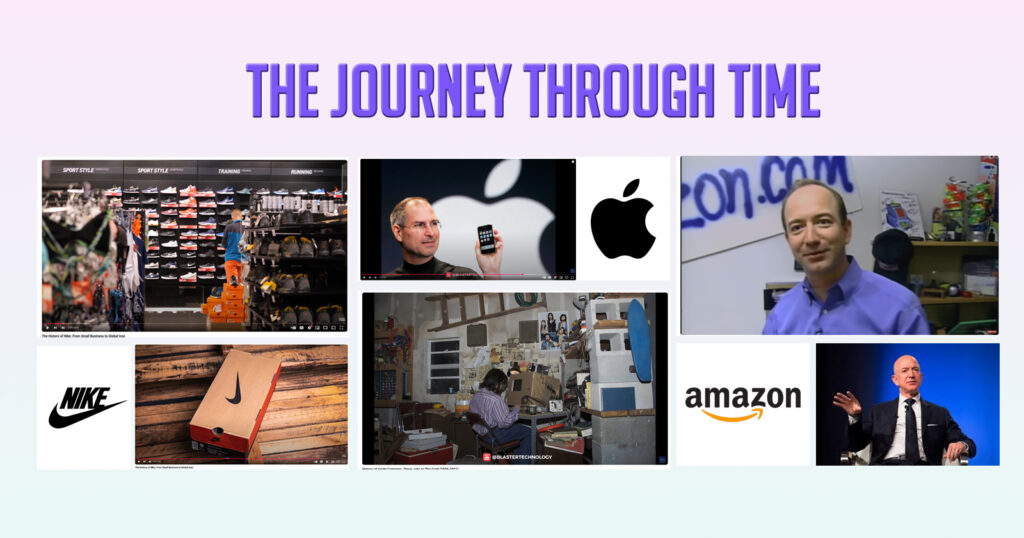
| Historical Event | How It Was Told | Impact |
|---|---|---|
| Nike’s History | Story of how Nike became a leading athletic brand. | Inspired loyalty and trust by showcasing innovation. |
| Apple’s Rise | Depicted Apple’s journey from a garage startup to a tech giant. | Enhanced the brand’s cultural significance and prestige. |
| Amazon’s Founding Story | Jeff Bezos’ vision for Amazon from book sales to e-commerce empire. | Highlighted perseverance and scalability of Amazon’s model. |
ShortVids is great at turning stories into videos that grab attention and drive results. For example, we helped Josh Peacock from SEO For Hire by turning long podcast interviews into short, engaging clips. This saved him time and helped his brand stand out. Just like that, we can help you turn your complicated ideas into clear, memorable videos. Whether you need to boost your brand or connect with your audience, ShortVids can help make it happen.
Key Elements for Crafting a Compelling Video Story
Creating a great video story isn’t just about showing a product – it’s about connecting with your audience in a way that makes them feel something. To do this, there are four key things you should focus on:
Relatable Characters and the Human Element
People connect with stories that feel real. Make sure your video has characters your audience can relate to. For example, if you’re a business selling to other businesses, sharing a story of how your product helped a customer succeed can make people feel connected to your brand.
Conflict and Resolution
Every good story has a problem that needs solving. In marketing, this could be showing a problem your audience faces and how your product can fix it. Think of a video showing how your product helps customers overcome a struggle, creating tension and offering a satisfying solution.
Creating Emotional Appeal
The best stories make people feel something – whether it’s happiness, laughter, or motivation. Use images, music, and characters to trigger those emotions, which will make your story more memorable and connect with your audience.
Effective Call to Action
Once you’ve told your story, make sure you guide your audience to take the next step. Whether it’s signing up for something, buying a product, or learning more, keep your call to action simple, clear, and tied to the story you just told.
By focusing on these four things, you’ll create video stories that capture attention and encourage people to act!
Tips to Make Your Video Storytelling Stand Out
When it comes to video storytelling, standing out from the crowd requires more than just good footage. To truly captivate your audience, you need to craft a story that’s both compelling and memorable. Here are some tips to help make your video storytelling effective and impactful:
- Stay concise and ensure your story delivers the message quickly. Viewers often have short attention spans, so keep your content focused and impactful.
- Grab your audience’s attention in the first few seconds and leave them with a powerful takeaway. A strong conclusion can leave a lasting impression.
- Audiences appreciate genuine stories. Be honest and authentic in your approach, connecting with viewers on a personal level.
- Visual storytelling is key. Use imagery and video to convey emotions and messages rather than relying solely on narration or text.
- Understand who you’re talking to and tailor your story to meet their interests, needs, and values. This ensures your message resonates deeply.
- High-quality visuals, whether it’s through motion graphics, b-roll, or dynamic shots, help to keep your audience engaged and enhance the narrative.
Common Mistakes to Avoid in Video Storytelling
When creating a compelling video story, there are some common pitfalls that can make your content less effective. Avoiding these mistakes ensures your video has the maximum impact and keeps your audience engaged. Here are the key mistakes to steer clear of in video storytelling:
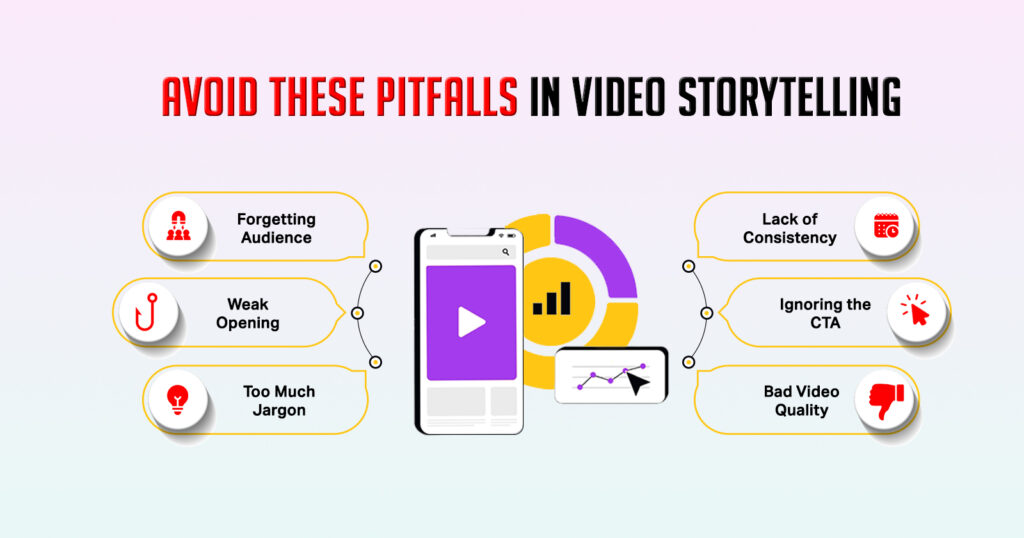
Overcomplicating the Story
It’s easy to get caught up in making your video too complex. Avoid cramming too much information or multiple storylines into one video. A clear, straightforward narrative works best for keeping your audience engaged.
Neglecting the Emotional Aspect
Video storytelling without emotional connection can fall flat. Whether you’re selling a product or telling a brand story, make sure the narrative evokes emotions—this helps the viewer connect with the message. Emotional stories are often the most memorable.
Unclear Messaging
When crafting a story, ensure your message is clear from beginning to end. An unclear or ambiguous message can confuse viewers, causing them to disengage. Stay focused on what you want the viewer to take away.
Forgetting the Call to Action
Never end your story without guiding your audience on what to do next. Whether it’s visiting a website, signing up, or making a purchase, a strong call to action is essential to converting viewers into customers.
ShortVids make sure you never make these mistakes. With our expert video editing services, we help you create perfect, clear, and compelling stories every time. Whether it’s creating emotional connections or adding the right visuals, we’ve got you covered to make sure your story resonates and delivers.
Conclusion
Video storytelling is a powerful way to connect with your audience and make your brand more relatable. Whether it’s through personal stories, customer experiences, or behind-the-scenes moments, storytelling adds meaning and emotion to your content. By using the right approach, you can keep your audience engaged and create a lasting impact. At ShortVids, we’re experts in turning your ideas into high-quality videos that tell your brand’s story in the best way.
Frequently Asked Questions
Storytelling in marketing helps brands connect emotionally with their audience, making the message more memorable and relatable. It can build trust, improve brand recall, and drive customer loyalty.
Storytelling in video involves using visuals, narrative, and emotion to convey a message or brand story. It engages the audience by turning complex ideas into relatable experiences.
Video marketing can be used to educate, promote products, or build brand awareness by creating engaging, shareable content. It allows businesses to connect with audiences through visual and emotional storytelling.
Storytelling is creative because it allows businesses to express their brand message in unique, compelling ways. It leverages imagination, emotions, and visuals to captivate and engage the audience.
Book a Call Today
- Fixed monthly plans starting at $999
- 24-hour turnaround time (or less) on all short-form edits
- 3-layer quality check system on every video
- No more chasing freelancers or managing editors
- Scale up to 50+ videos/month without hiring in-house
- Content team trained on platform trends, scroll-stopping hooks & storytelling
- Fully managed by professionals – you just upload & approve
- Response time: Under 1 hour (US & GCC time zones)
Cut your production costs, not your standards.

